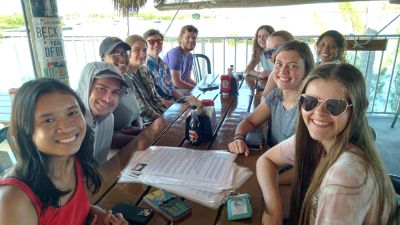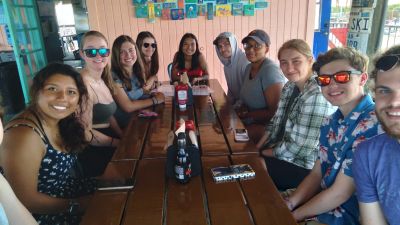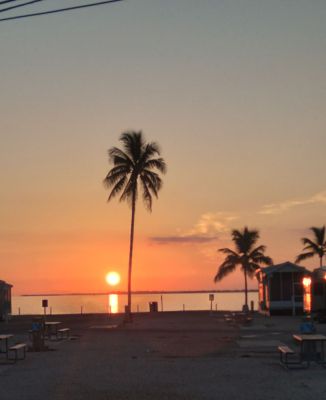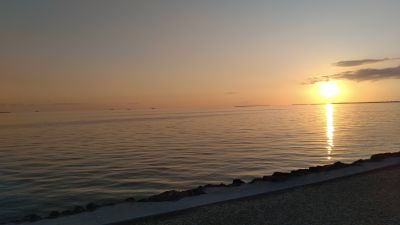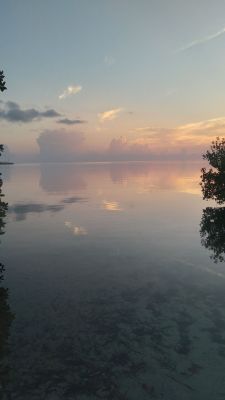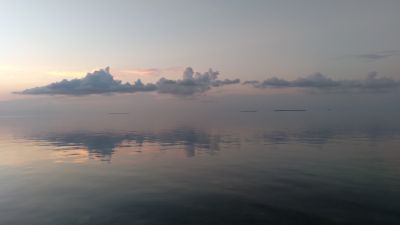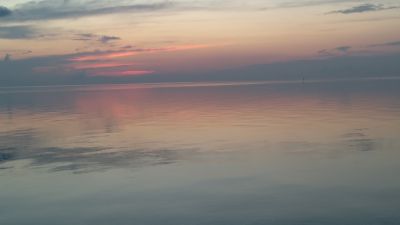Our last two days in the Florida Keys were full! Students took the final exam over ecological theories we’ve been learning – the important differences between marine and terrestrial environments, foundational and keystone species, facilitative interactions, trophic cascades, and marine system management. Students also presented the results of their research projects. After cleaning and storing our research equipment, we went out for dinner together with deep fried key lime pie for dessert. The ocean was beautifully smooth on our last day and provided one last amazing sunrise and sunset for us.
We have enjoyed each other’s company for three weeks and shared many adventures and laughs. Collectively we are feeling grateful for the opportunity to learn together in this amazing marine system, but are also eager to return home to our friends and family.
As part of the final exam, students were asked to identify 1-2 key ideas they are taking from the course. Here’s what they shared:
- The more and more I learn about biology, the more and more I learn how important diversity is for overall health of systems, both terrestrial and marine. It’s importance is due to the fact that by being in a diverse area, there are positive interactions between species, intentional and not intentional. It’s a fascinating thing to learn about, but also a very good reminder that we can’t do it alone, and that I will be healthier and happier working with and being around a larger diverse set of people. I think it’s a wonderful metaphor for us humans. – Trevor
- The vast interconnectedness and complexity of marine systems makes them fragile to entire collapses since all are significantly influenced by differing levels of a trophic system. Global warming and changes in salinity and temperature have the potential to cause imbalance and therefore collapsing systems. Also, the ocean is ancient, and many organisms still in existence in the ocean predate dinosaurs (such as the Horseshoe crab of the order Xiphosura). This means that though these organisms are still in existence, they are not immune to oceanic change, and the ocean requires much more attention and care before it is too late. – Maija
- What stood out greatest to me during this course is the volatility of facilitation, where positive interactions only stay positive when the conditions are stressful enough to encourage their existence. I would have originally viewed mutualisms such as mycorrhizal fungi with plant roots or sea sponge (Porifera) with red mangrove roots (Rhizophora mangle) to be always beneficial, as they provide each other with nutrients (nitrogen from the sponges, carbon from the mangroves) to allow both to thrive. However, I have started to learn that in certain situations, these beneficial sponges or fungi could turn into parasites—if nutrients are prevalent enough that these nitrogen-providing organisms are no longer helpful, then the plants may be at risk of being outcompeted by plants without those organisms sapping away carbon. This class has allowed me to view what I had learned in previous courses through a new lens and expand my understanding of life both terrestrial and marine. I am very grateful for having gotten the chance to know more about the fascinating ecological web of our Earth! – Jonah
- Marine systems are more connected and complex than we know. The “openness” of the system gives the wrong idea at first glance. Trophic cascades can attest that the interconnectivity of species can make or break an ecosystem and the balance between them. Before I thought that taking away a top predator (like humans) could balance out the marine systems and would increase productivity for other species. However this was challenged as I learned that predators are probably the most important part of the marine systems. Taking away the predators will only make the system collapse on itself. The predators keep the balance between organisms and help to make sure there is fair competition between species. Another thing I learned was the importance of grazers to the environment. Especially in the Florida Keys, Thalassia is the dominant seagrass but it is not outcompeting other seagrasses because the grazers keep them from overtaking seagrass beds. Just as predators keep the balance, so do herbivores. – Brie
- One biological concept in marine systems that has always struck me is simply the spatial scale of everything. The ocean is a vast system with so much diversity and we never know what we are going to see on any given day. This spatial scale is so important because it leads to concepts of genetic diversity and movement throughout ecosystems and between different systems. As larvae move through the water column, they are being dispersed throughout the entire system and potentially the world (given that they end up in a place that is habitable for them). Another thing that struck was that although there is such a wide distribution of organisms, marine systems aren’t as genetically diverse as one might think. Many species are capable of self-fertilization, and this is what they must do for their species to survive, even if it means not increasing overall genetic diversity. – Zoe
- The main biological idea that struck me during this course was the positive interactions between Rhizophora mangle and Porifera. My senior research project will study Porifera and how they tolerate different levels of sediment and how sediment can affect their dispersion in different habitats. When doing all this research I learned a lot about Porifera, but when joining this class and learning that they have symbiotic relationship with the prop-roots of Rhizophora mangle, I was blown away. I thought that was so cool and interesting especially after all the research I had already done about Porifera. This new information made the mangroves super interesting to me and almost made me change my project to focus on the interaction between Rhizophora mangle and Porifera. It also made me curious as to what other positive interactions Porifera have with other species. – Ashley
- The idea that stuck with me the most during my experience in this course is how immensely complex and interconnected marine systems are. There are so many different lenses you can look at things, and so many levels of trophic and taxonomic structure. Marine systems truly do have an unrivaled level of diversity, and that is just the part we know about! Most of the ocean is the deep ocean, which humans haven’t really explored. Even just in the habitats we were looking at, which were often shallow, you needed to hover over a patch of grass to really see all the small organisms that were residing there. I had never seen that kind of complex diversity before in quite the same way, and it is beautiful. – Julia
- The idea that struck me the most in this marine biology course is how connected everything is in the ocean. There is not one thing that is not connected to another. Trophic cascades reinforce this idea because if manatees are not eating Thalassia, there will be an overgrowth in Thalassia, decreasing biodiversity. – Destiny
- I thoroughly enjoyed learning the taxonomic names for creatures in the habitats we explored. I appreciated this part of the course for two reasons. One, it was a throwback to a zoology course I had taken in high school which I had no idea I would ever use the knowledge from. It was enjoyable to see some of the knowledge I learned there come up in a college level course. Second, learning the names of over 80 different classifications helped me to appreciate the diversity I saw in the marine habitats around me. It would have been easy for me to see a seagrass bed and say it all looks the same, but after learning the taxonomy it allowed me to see an incredible amount of diversity. – Henry
- My biggest lesson learned so far, is that marine animals have so much more to consider than terrestrial creatures. They have to worry about what is above, below, behind and in front of them at all times. Marine animals have so many predators, prey and unknowns everywhere that they are so much more at risk, and have a disadvantage because of the 3D and open nature of their habitat. The other thing I found really interesting was our time spent learning about policy regarding marine habitats, specifically the MPA’s and Marine Reserves. 20% of diet in the world is from marine animals, and it made me realize how much more policy needs to be enacted in the United States, especially as global warming is killing habitats, and we are polluting water so much. If we help the marine environment it can help us in the future, we just need to take steps to protect it and help it thrive again. – Mia








